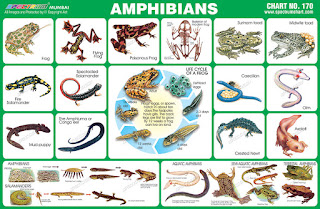Frog – Frogs are a
diverse and largely carnivorous group of short-bodied, tailless
amphibians composing the order Anura. Frog have long hind legs,
elongated ankle bones, webbed toes, no claws, large eyes and a
smooth or warty skin. Like other amphibians, oxygen can pass through
their highly permeable skins.
Flying Frog – A flying
frog (also called a gliding frog) is a frog that has the ability to
achieve gliding flight. That is, it can descend at an angle of less
than 45° relative to the horizontal. Other arboreal frogs can also
descend vertically, but only at angles greater than 45°, which is
referred to as parachuting.
Poisonous Frog - Poison
frog (also known as dart-poison frog) is the common name of a group
of frogs in the family Dendrobatidae which are native to tropical
Central and South America. Most poison dart frogs are brightly
coloured. Their bright coloration is associated with their toxicity
and levels of alkaloids.
Surinam Toad - Suriname
toad is a species of frog in the Pipidae family found in South
America. They are almost completely flat. Its feet are broadly
webbed with the front toes Specimens of close to 20 cm in length
have been recorded, although 10–13 cm (4–5 in) is a typical
size. The Suriname toad has minute eyes, no teeth and no tongue.
Midwife Toad - Midwife
toads are a genus of frogs in the Alytidae family and are found in
most of Europe and northwestern Africa. Characteristic of these toad
is their parental care, the males carry a string of fertilised eggs
on their back, hence the name "midwife". They are
nocturnal animals.
Fire Salamander - Fire
Salamander is probably the most well-known salamander species in
Europe. It is black and has different kinds of yellow spots or
stripes. Fire Salamanders live in forests in the hilly parts of
southern and central Europe. They prefer deciduous forests. The diet
of the fire salamander consists of various insects, spiders,
earthworms and slugs.
Spectacled Salamander -
Spectacled Salamander is a species of salamander in the
Salamandridae family. This species is found only in the Apennine
Range in Italy in humid valleys and shady, overgrown hillsides at
altitudes between 200 and 1200 m. It has a warty, brownish-black
back, and a ribbed appearance on its flanks, with a creamy white,
V-shaped mark between the eyes.
Caecilian - Caecilians are
a group of limbless, serpentine amphibians. Caecilians completely
lack limbs. Their tails are short or absent. Their skin is smooth
and usually dark, but some species have colourful skins. Caecilians
are found in wet, tropical regions of Southeast Asia, parts of East
and West Africa, Central America and in northern and eastern South
America.
Olm – Olm or proteus is
an aquatic salamander in the family Proteidae, the only exclusively
cave-dwelling chordate species found in Europe. In contrast to most
amphibians, it is entirely aquatic it eats, sleeps and breeds
underwater. Olm's body is snakelike, 20–30 cm long.
Mud-puppy – Mudpuppy is a
species of salamander in the genus Necturus. Mudpuppies live in
streams, lakes and ponds in the eastern part of North America. They
are usually a rusty brown colour and can grow to an average length
of 33 cm. Mudpuppies are nocturnal creatures.
Amphiuma or Congo Eel –
Amphiuma is a genus of aquatic salamanders, the only extant genus
within the family Amphiumidae. Amphiumas have an elongated body,
generally grey-black in colour. They do have legs, but they are
merely vestigial and very small. While amphiumas can be up to 116 cm
long, their legs measure only up to about 2 cm.
Crested Newt - Crested Newt
is a newt in the family Salamandridae, found across Europe and parts
of Asia. It is a relatively large species measuring upto 14 to 15 cm
long. These newts have dark grey-brown backs and flanks and are
covered with darker-coloured spots so they appear almost black.
Their undersides are either yellow- or orange-coloured and are
covered in large, black blotches.
Axolotl - Axolotl is a type
of amphibian that represents unmetamorphosed larvae of the Mexican
salamander. Unlike other amphibians, axolotl spends its entire life
in the water. Axolotl looks like a tadpole with limbs, dorsal fin
and a pair of external gills. Axolotl does not have eyelids. Axolotl
is a carnivore. Axolotl has unique capability to regenerate
different parts of its body in the case they are lost or damaged.
This unique-looking animal is listed as critical endangered.


No comments:
Post a Comment